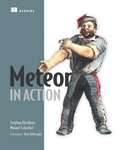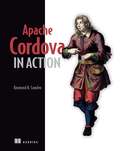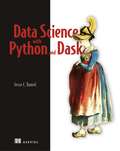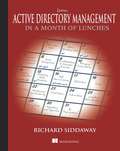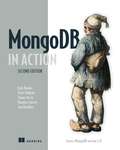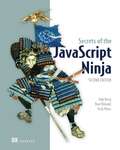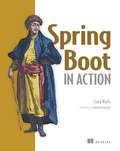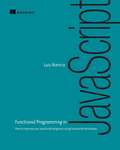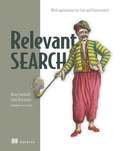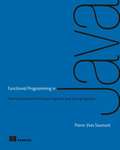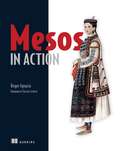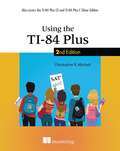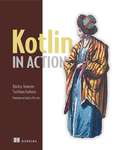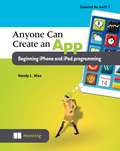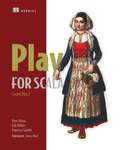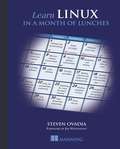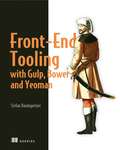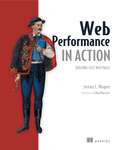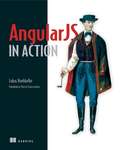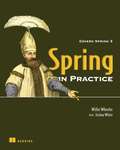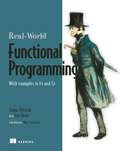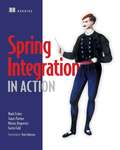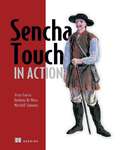- Table View
- List View
Meteor in Action
by Stephan Hochhaus Manuel SchoebelSummaryMeteor in Action teaches you full-stack web development using the Meteor platform. It starts with an overview of a Meteor application, revealing the unique nature of Meteor's end-to-end application model. Then you'll dive into the Blaze templating engine, discover Meteor's reactive data sources model, learn simple and advanced routing techniques, and practice managing users, permissions, and roles. Purchase of the print book includes a free eBook in PDF, Kindle, and ePub formats from Manning Publications.About the BookYou might call Meteor a reactive, isomorphic, full-stack web development framework. Or, like most developers who have tried it, you might just call it awesome. Meteor is a JavaScript-based framework for both client and server web and mobile applications. Meteor applications react to changes in data instantly, so you get impossibly responsive user experiences, and the consistent build process, unified front- and back-end package system, and one-command deploys save you time at every step from design to release.Meteor in Action teaches you full-stack web development with Meteor. It starts by revealing the unique nature of Meteo's end-to-end application model. Through real-world scenarios, you'll dive into the Blaze templating engine, discover Meteor's reactive data sources model, learn routing techniques, and practice managing users, permissions, and roles. Finally, you'll learn how to deploy Meteor on your server and scale efficiently.What's InsideBuilding your first real-time applicationUsing MongoDB and other reactive data sourcesCreating applications with Iron RouterDeploying and scaling your applicationsAbout the ReaderReaders need to know the basics of JavaScript and understand general web application design.About the AuthorsStephan Hochhaus and Manuel Schoebel are veteran web developers who have worked with Meteor since its infancy.Table of ContentsPART 1 LOOK—A SHOOTING STAR!A better way to build appsMy fridge! A reactive gamePART 2 3, 2, 1—IMPACT!Working with templatesWorking with dataFully reactive editingUsers, authentications, and permissionsExchanging dataRouting using Iron.RouterThe package systemAdvanced server methodsPART 3 LEAVING THE CRATERBuilding and debuggingGoing into production
Apache Cordova in Action
by Raymond K. CamdenSummaryApache Cordova in Action teaches you to create and launch hybrid mobile apps using Cordova or Phonegap. By following carefully selected examples, step-by-step tutorials, and crystal-clear explanations, you'll learn to build apps from the Cordova CLI, how to make use of device features like the camera and accelerometer, how to submit your apps to Google Play and the Apple App Store, and more.Purchase of the print book includes a free eBook in PDF, Kindle, and ePub formats from Manning Publications.About the BookDeveloping a mobile app requires extensive knowledge of native programming techniques for multiple platforms. Apache Cordova lets you use your existing skills in web development (HTML, CSS, and JavaScript) to build powerful mobile apps. Your apps also get the power of integration with native device features like the camera and file system.Apache Cordova in Action teaches you how to design, create, and launch hybrid mobile apps people will want to use. With the help of straightforward, real-world examples, you'll learn to build apps from the Cordova CLI and to make use of native device features like the camera and accelerometer. You'll learn testing techniques and discover the PhoneGap Build service and how to submit your apps to Google Play and the Apple App Store. Along the way, this helpful guide discusses mobile app design and shows you how to create effective, professional-quality UI and UX.What's InsideBuild mobile appsUI, UX, and testing techniquesDeploy to Google Play and the Apple App StoreEmploy libraries like Bootstrap, jQuery Mobile, and IonicAbout the ReaderReaders should be familiar with HTML, CSS, and JavaScript. No experience with mobile app development needed.About the AuthorRaymond Camden is a developer advocate for IBM. He is passionate about mobile development and has spoken at conferences worldwide.The Table of ContentsPART 1 GETTING STARTED WITH APACHE CORDOVAWhat is Cordova?Installing Cordova and the Android SDKPART 2 CORE CONCEPTSCreating Cordova projectsUsing plugins to access device featuresMobile design and user experienceConsiderations when building mobile appsTools for debugging Cordova and other hybrid appsCreating custom pluginsPacking options for Cordova projectsUsing PhoneGap toolsPART 3 APPLICATION RELEASESubmitting your appBuilding an RSS reader app with Ionic
Data Science with Python and Dask
by Jesse DanielSummaryDask is a native parallel analytics tool designed to integrate seamlessly with the libraries you're already using, including Pandas, NumPy, and Scikit-Learn. With Dask you can crunch and work with huge datasets, using the tools you already have. And Data Science with Python and Dask is your guide to using Dask for your data projects without changing the way you work!Purchase of the print book includes a free eBook in PDF, Kindle, and ePub formats from Manning Publications. You'll find registration instructions inside the print book.About the TechnologyAn efficient data pipeline means everything for the success of a data science project. Dask is a flexible library for parallel computing in Python that makes it easy to build intuitive workflows for ingesting and analyzing large, distributed datasets. Dask provides dynamic task scheduling and parallel collections that extend the functionality of NumPy, Pandas, and Scikit-learn, enabling users to scale their code from a single laptop to a cluster of hundreds of machines with ease.About the BookData Science with Python and Dask teaches you to build scalable projects that can handle massive datasets. After meeting the Dask framework, you'll analyze data in the NYC Parking Ticket database and use DataFrames to streamline your process. Then, you'll create machine learning models using Dask-ML, build interactive visualizations, and build clusters using AWS and Docker. What's insideWorking with large, structured and unstructured datasetsVisualization with Seaborn and DatashaderImplementing your own algorithmsBuilding distributed apps with Dask DistributedPackaging and deploying Dask appsAbout the ReaderFor data scientists and developers with experience using Python and the PyData stack.About the AuthorJesse Daniel is an experienced Python developer. He taught Python for Data Science at the University of Denver and leads a team of data scientists at a Denver-based media technology company.Table of ContentsPART 1 - The Building Blocks of scalable computingWhy scalable computing matters Introducing Dask PART 2 - Working with Structured Data using Dask DataFrames Introducing Dask DataFrames Loading data into DataFrames Cleaning and transforming DataFrames Summarizing and analyzing DataFrames Visualizing DataFrames with Seaborn Visualizing location data with Datashader PART 3 - Extending and deploying DaskWorking with Bags and Arrays Machine learning with Dask-ML Scaling and deploying Dask
Learn Active Directory Management in a Month of Lunches
by Richard SiddawaySummaryLearn Active Directory Management in a Month of Lunches is a practical, hands-on tutorial designed for IT pros new to Active Directory. It skips the theory and concentrates on the day-to-day administration tasks you need to know to keep your network running smoothly. Just set aside an hour a day for a month—lunchtime would be perfect—and you'll be comfortable and productive with Active Directory before you know it.About the BookAt the heart of your Windows network is Active Directory, the control center for administration, security, and other core management functions. If you're new to Active Directory administration—or if you find yourself unexpectedly thrust into that role—you'll need to get up to speed fast.Learn Active Directory Management in a Month of Lunches is a hands-on tutorial designed for IT pros new to Active Directory. Without assuming previous administration experience, the book starts by walking you through the most important day-to-day system management tasks. You'll learn how to administer AD both from the GUI tools built into Windows and by using PowerShell at the command line. Along the way, you'll touch on best practices for managing user access, setting group policies, automating backups, and more.This book assumes no prior experience with Active Directory or Windows administration. Examples are based in Windows Server 2012Purchase of the print book includes a free eBook in PDF, Kindle, and ePub formats from Manning Publications.What's InsideADM tasks you'll need every dayGUI and command line techniquesContent tested by new administratorsWell-illustrated, clearly explained examplesAbout the AuthorRichard Siddaway is an experienced all-around Windows administrator with two decades of experience. He's the author of PowerShell in Practice andPowerShell and WMI, and coauthor of PowerShell in Depth.Table of ContentsPART 1 MANAGING ACTIVE DIRECTORY DATABefore you beginCreating user accountsManaging user accountsManaging groupsTroubleshooting users and groupsManaging computer accountsManaging organizational unitsPART 2 MANAGING GROUP POLICYCreating Group PoliciesManaging Group PoliciesFine-grained password policiesPART 3 MANAGING THE ACTIVE DIRECTORY SERVICECreating domain controllersManaging domain controllersProtecting AD data Security: Default groups and delegationManaging DNSManaging sites and subnetsAD replicationManaging AD trustsPART 4 MAINTENANCE AND TROUBLESHOOTINGTroubleshooting your AD Maintaining and monitoring Active DirectoryFuture work and final examInto the cloud
MongoDB in Action: Covers MongoDB version 3.0
by Kyle Banker Douglas Garrett Peter Bakkum Shaun VerchSummaryMongoDB in Action, Second Edition is a completely revised and updated version. It introduces MongoDB 3.0 and the document-oriented database model. This perfectly paced book gives you both the big picture you'll need as a developer and enough low-level detail to satisfy system engineers.Purchase of the print book includes a free eBook in PDF, Kindle, and ePub formats from Manning Publications.About the TechnologyThis document-oriented database was built for high availability, supports rich, dynamic schemas, and lets you easily distribute data across multiple servers. MongoDB 3.0 is flexible, scalable, and very fast, even with big data loads.About the BookMongoDB in Action, Second Edition is a completely revised and updated version. It introduces MongoDB 3.0 and the document-oriented database model. This perfectly paced book gives you both the big picture you'll need as a developer and enough low-level detail to satisfy system engineers. Lots of examples will help you develop confidence in the crucial area of data modeling. You'll also love the deep explanations of each feature, including replication, auto-sharding, and deployment.What's InsideIndexes, queries, and standard DB operationsAggregation and text searchingMap-reduce for custom aggregations and reportingDeploying for scale and high availabilityUpdated for Mongo 3.0 About the ReaderWritten for developers. No previous MongoDB or NoSQL experience is assumed.About the AuthorsAfter working at MongoDB, Kyle Banker is now at a startup. Peter Bakkum is a developer with MongoDB expertise. Shaun Verch has worked on the core server team at MongoDB. A Genentech engineer, Doug Garrett is one of the winners of the MongoDB Innovation Award for Analytics. A software architect, Tim Hawkins has led search engineering at Yahoo Europe. Technical Contributor: Wouter Thielen. Technical Editor: Mihalis Tsoukalos. Table of ContentsPART 1 GETTING STARTEDA database for the modern web MongoDB through the JavaScript shell Writing programs using MongoDB PART 2 APPLICATION DEVELOPMENT IN MONGODBDocument-oriented data Constructing queries Aggregation Updates, atomic operations, and deletes PART 3 MONGODB MASTERYIndexing and query optimization Text search WiredTiger and pluggable storage Replication Scaling your system with sharding Deployment and administration
Secrets of the JavaScript Ninja
by Josip MarasSummaryMore than ever, the web is a universal platform for all types of applications, and JavaScript is the language of the web. If you're serious about web development, it's not enough to be a decent JavaScript coder. You need to be ninja-stealthy, efficient, and ready for anything. This book shows you how.Purchase of the print book includes a free eBook in PDF, Kindle, and ePub formats from Manning Publications.About the TechnologyJavaScript is rapidly becoming a universal language for every type of application, whether on the web, on the desktop, in the cloud, or on mobile devices. When you become a JavaScript pro, you have a powerful skill set that’s usable across all these domains.About the BookSecrets of the JavaScript Ninja, Second Edition uses practical examples to clearly illustrate each core concept and technique. This completely revised edition shows you how to master key JavaScript concepts such as functions, closures, objects, prototypes, and promises. It covers APIs such as the DOM, events, and timers. You’ll discover best practice techniques such as testing, and cross-browser development, all taught from the perspective of skilled JavaScript practitioners.What’s InsideWriting more effective code with functions, objects, and closuresLearning to avoid JavaScript application pitfallsUsing regular expressions to write succinct text-processing codeManaging asynchronous code with promisesFully revised to cover concepts from ES6 and ES7About the ReaderYou don’t have to be a ninja to read this book—just be willing to become one. Are you ready?About the AuthorsJohn Resig is an acknowledged JavaScript authority and the creator of the jQuery library. Bear Bibeault is a web developer and author of the first edition, as well as coauthor of Ajax in Practice, Prototype and Scriptaculous in Action, and jQuery in Action from Manning. Josip Maras is a post-doctoral researcher and teacher.Table of ContentsPART 1 - WARMING UPJavaScript is everywhereBuilding the page at runtimePART 2 - UNDERSTANDING FUNCTIONSFirst-class functions for the novice: definitions and arguments Functions for the journeyman: understanding function invocation Functions for the master: closures and scopesFunctions for the future: generators and promisesPART 3 - DIGGING INTO OBJECTS AND FORTIFYING YOUR CODEObject orientation with prototypesControlling access to objectsDealing with collectionsWrangling regular expressionsCode modularization techniquesPART 4 - BROWSER RECONNAISSANCEWorking the DOMSurviving eventsDeveloping cross-browser strategies
Spring Boot in Action
by Craig WallsSummaryA developer-focused guide to writing applications using Spring Boot. You'll learn how to bypass the tedious configuration steps so that you can concentrate on your application's behavior.Purchase of the print book includes a free eBook in PDF, Kindle, and ePub formats from Manning Publications.About the TechnologyThe Spring Framework simplifies enterprise Java development, but it does require lots of tedious configuration work. Spring Boot radically streamlines spinning up a Spring application. You get automatic configuration and a model with established conventions for build-time and runtime dependencies. You also get a handy command-line interface you can use to write scripts in Groovy. Developers who use Spring Boot often say that they can't imagine going back to hand configuring their applications.About the BookSpring Boot in Action is a developer-focused guide to writing applications using Spring Boot. In it, you'll learn how to bypass configuration steps so you can focus on your application's behavior. Spring expert Craig Walls uses interesting and practical examples to teach you both how to use the default settings effectively and how to override and customize Spring Boot for your unique environment. Along the way, you'll pick up insights from Craig's years of Spring development experience.What's InsideDevelop Spring apps more efficientlyMinimal to no configurationRuntime metrics with the ActuatorCovers Spring Boot 1.3About the ReaderWritten for readers familiar with the Spring Framework.About the AuthorCraig Walls is a software developer, author of the popular book Spring in Action, Fourth Edition, and a frequent speaker at conferences.Table of ContentsBootstarting SpringDeveloping your first Spring Boot applicationCustomizing configurationTesting with Spring BootGetting Groovy with the Spring Boot CLIApplying Grails in Spring BootTaking a peek inside with the ActuatorDeploying Spring Boot applicationsAPPENDIXESSpring Boot developer toolsSpring Boot startersConfiguration propertiesSpring Boot dependencies
Functional Programming in JavaScript: How to improve your JavaScript programs using functional techniques
by Luis AtencioSummaryFunctional Programming in JavaScript teaches JavaScript developers functional techniques that will improve extensibility, modularity, reusability, testability, and performance. Through concrete examples and jargon-free explanations, this book teaches you how to apply functional programming to real-life development tasksPurchase of the print book includes a free eBook in PDF, Kindle, and ePub formats from Manning Publications.About the TechnologyIn complex web applications, the low-level details of your JavaScript code can obscure the workings of the system as a whole. As a coding style, functional programming (FP) promotes loosely coupled relationships among the components of your application, making the big picture easier to design, communicate, and maintain.About the BookFunctional Programming in JavaScript teaches you techniques to improve your web applications - their extensibility, modularity, reusability, and testability, as well as their performance. This easy-to-read book uses concrete examples and clear explanations to show you how to use functional programming in real life. If you're new to functional programming, you'll appreciate this guide's many insightful comparisons to imperative or object-oriented programming that help you understand functional design. By the end, you'll think about application design in a fresh new way, and you may even grow to appreciate monads!What's InsideHigh-value FP techniques for real-world usesUsing FP where it makes the most senseSeparating the logic of your system from implementation detailsFP-style error handling, testing, and debuggingAll code samples use JavaScript ES6 (ES 2015)About the ReaderWritten for developers with a solid grasp of JavaScript fundamentals and web application design.About the AuthorLuis Atencio is a software engineer and architect building enterprise applications in Java, PHP, and JavaScript.Table of ContentsPART 1 THINK FUNCTIONALLYBecoming functional Higher-order JavaScript PART 2 GET FUNCTIONALFew data structures, many operations Toward modular, reusable code Design patterns against complexityPART 3 ENHANCING YOUR FUNCTIONAL SKILLSBulletproofing your codeFunctional optimizations Managing asynchronous events and data
Relevant Search: With applications for Solr and Elasticsearch
by John Berryman Doug TurnbullSummaryRelevant Search demystifies relevance work. Using Elasticsearch, it teaches you how to return engaging search results to your users, helping you understand and leverage the internals of Lucene-based search engines.Purchase of the print book includes a free eBook in PDF, Kindle, and ePub formats from Manning Publications.About the TechnologyUsers are accustomed to and expect instant, relevant search results. To achieve this, you must master the search engine. Yet for many developers, relevance ranking is mysterious or confusing. About the BookRelevant Search demystifies the subject and shows you that a search engine is a programmable relevance framework. You'll learn how to apply Elasticsearch or Solr to your business's unique ranking problems. The book demonstrates how to program relevance and how to incorporate secondary data sources, taxonomies, text analytics, and personalization. In practice, a relevance framework requires softer skills as well, such as collaborating with stakeholders to discover the right relevance requirements for your business. By the end, you'll be able to achieve a virtuous cycle of provable, measurable relevance improvements over a search product's lifetime. What's InsideTechniques for debugging relevance?Applying search engine features to real problems?Using the user interface to guide searchers?A systematic approach to relevance?A business culture focused on improving searchAbout the ReaderFor developers trying to build smarter search with Elasticsearch or Solr.About the AuthorsDoug Turnbull is lead relevance consultant at OpenSource Connections, where he frequently speaks and blogs. John Berryman is a data engineer at Eventbrite, where he specializes in recommendations and search.Foreword author, Trey Grainger, is a director of engineering at CareerBuilder and author of Solr in Action.Table of ContentsThe search relevance problem Search under the hood Debugging your first relevance problem Taming tokens Basic multifield search Term-centric search Shaping the relevance function Providing relevance feedback Designing a relevance-focused search applicationThe relevance-centered enterprise Semantic and personalized search
Functional Programming in Java: How functional techniques improve your Java programs
by Pierre-Yves SaumontSummaryFunctional Programming in Java teaches Java developers how to incorporate the most powerful benefits of functional programming into new and existing Java code. You'll learn to think functionally about coding tasks in Java and use FP to make your applications easier to understand, optimize, maintain, and scale. Purchase of the print book includes a free eBook in PDF, Kindle, and ePub formats from Manning Publications.About the TechnologyHere's a bold statement: learn functional programming and you'll be a better Java developer. Fortunately, you don't have to master every aspect of FP to get a big payoff. If you take in a few core principles, you'll see an immediate boost in the scalability, readability, and maintainability of your code. And did we mention that you'll have fewer bugs? Let's get started!About the BookFunctional Programming in Java teaches you how to incorporate the powerful benefits of functional programming into new and existing Java code. This book uses easy-to-grasp examples, exercises, and illustrations to teach core FP principles such as referential transparency, immutability, persistence, and laziness. Along the way, you'll discover which of the new functionally inspired features of Java 8 will help you most.What's InsideWriting code that's easier to read and reason aboutSafer concurrent and parallel programmingHandling errors without exceptionsJava 8 features like lambdas, method references, and functional interfacesAbout the ReaderWritten for Java developers with no previous FP experience.About the AuthorPierre-Yves Saumont is a seasoned Java developer with three decades of experience designing and building enterprise software. He is an R&D engineer at Alcatel-Lucent Submarine Networks.Table of ContentsWhat is functional programming? Using functions in Java Making Java more functional Recursion, corecursion, and memoization Data handling with lists Dealing with optional data Handling errors and exceptions Advanced list handling Working with laziness More data handling with trees Solving real problems with advanced trees Handling state mutation in a functional wayFunctional input/output Sharing mutable state with actors Solving common problems functionally
Mesos in Action
by Roger IgnazioSummaryMesos in Action introduces readers to the Apache Mesos cluster manager and the concept of application-centric infrastructure. Filled with helpful figures and hands-on instructions, this book guides you from your first steps creating a highly-available Mesos cluster through deploying applications in production and writing native Mesos frameworks.Purchase of the print book includes a free eBook in PDF, Kindle, and ePub formats from Manning Publications.About the TechnologyModern datacenters are complex environments, and when you throw Docker and other container-based systems into the mix, there’s a great need to simplify. Mesos is an open source cluster management platform that transforms the whole datacenter into a single pool of compute, memory, and storage resources that you can allocate, automate, and scale as if you’re working with a single supercomputer.About the BookMesos in Action introduces readers to the Apache Mesos cluster manager and the concept of application-centric infrastructure. Filled with helpful figures and hands-on instructions, this book guides you from your first steps creating a highly-available Mesos cluster through deploying applications in production and writing native Mesos frameworks. You’ll learn how to scale to thousands of nodes, while providing resource isolation between processes using Linux and Docker containers. You’ll also learn practical techniques for deploying applications using popular key frameworks.What’s InsideSpinning up your first Mesos clusterScheduling, resource administration, and loggingDeploying containerized applications with Marathon, Chronos, and AuroraWriting Mesos frameworks using PythonAbout the ReaderReaders need to be familiar with the core ideas of datacenter administration and need a basic knowledge of Python or a similar programming language.About the AuthorRoger Ignazio is an experienced systems engineer with a focus on distributed, fault-tolerant, and scalable infrastructure. He is currently a technical lead at Mesosphere. Table of ContentsPART 1 HELLO, MESOSIntroducing MesosManaging datacenter resources with MesosPART 2 CORE MESOSSetting up MesosMesos fundamentalsLogging and debuggingMesos in productionPART 3 RUNNING ON MESOSDeploying applications with MarathoNManaging scheduled tasks with ChronosDeploying applications and managing scheduled tasks with AuroraDeveloping a framework
Using the TI-84 Plus
by Christopher MitchellSummaryThis easy-to-follow book includes terrific tutorials and plenty of exercises and examples that let you learn by doing. It starts by giving you a hands-on orientation to the TI-84 Plus calculator. Then, you'll start exploring key features while you tackle problems just like the ones you'll see in your math and science classes.Purchase of the print book includes a free eBook in PDF, Kindle, and ePub formats from Manning Publications.About this BookWith so many features and functions, the TI-84 Plus graphing calculator can be a little intimidating. But fear not if you have this book in your hand! In it you'll find terrific tutorials ranging from mastering basic skills to advanced graphing and calculation techniques, along with countless examples and exercises that let you learn by doing.Using the TI-84 Plus, Second Edition starts by making you comfortable with the screens, buttons, and special vocabulary you'll use every time you fire up the TI-84 Plus. Then, you'll master key features and techniques while you tackle problems just like the ones you'll see in your math and science classes. You'll even get tips for using the TI-84 Plus on the SAT and ACT math sections!No advanced knowledge of math or science is required.What's InsideLearn hands-on with real examples and exercisesFind specific answers fastCompliant with all models of the TI-83 Plus and TI-84 PlusFull coverage of the color-screen TI-84 Plus CE and TI-84 Plus C Silver EditionChristopher Mitchell, PhD. is a research scientist studying distributed systems, the founder of the programming and calculator support site cemetech.net, and the author of Manning's Programming the TI-83 Plus/ TI-84 Plus.Table of ContentsPART 1 BASICS AND ALGEBRA ON THE TI-84 PLUSWhat can your calculator do?Get started with your calculatorBasic graphingVariables, matrices, and listsPART 2 PRECALCULUS AND CALCULUSExpanding your graphing skillsPrecalculus and your calculatorCalculus on the TI-83 Plus/TI-84 PlusPART 3 STATISTICS, PROBABILITY, AND FINANCECalculating and plotting statisticsWorking with probability and distributionsFinancial toolsPART 4 GOING FURTHER WITH THE TI-83 PLUS/TI-84 PLUSTurbocharging math with programmingThe TI-84 Plus CE and TI-84 Plus C Silver EditionNow what?
Kotlin in Action
by Dmitry Jemerov Svetlana IsakovaSummaryKotlin in Action guides experienced Java developers from the language basics of Kotlin all the way through building applications to run on the JVM and Android devices. Foreword by Andrey Breslav, Lead Designer of Kotlin.Purchase of the print book includes a free eBook in PDF, Kindle, and ePub formats from Manning Publications.About the TechnologyDevelopers want to get work done - and the less hassle, the better. Coding with Kotlin means less hassle. The Kotlin programming language offers an expressive syntax, a strong intuitive type system, and great tooling support along with seamless interoperability with existing Java code, libraries, and frameworks. Kotlin can be compiled to Java bytecode, so you can use it everywhere Java is used, including Android. And with an effi cient compiler and a small standard library, Kotlin imposes virtually no runtime overhead.About the BookKotlin in Action teaches you to use the Kotlin language for production-quality applications. Written for experienced Java developers, this example-rich book goes further than most language books, covering interesting topics like building DSLs with natural language syntax. The authors are core Kotlin developers, so you can trust that even the gnarly details are dead accurate.What's InsideFunctional programming on the JVMWriting clean and idiomatic codeCombining Kotlin and JavaDomain-specific languagesAbout the ReaderThis book is for experienced Java developers.About the AuthorDmitry Jemerov and Svetlana Isakova are core Kotlin developers at JetBrains.Table of ContentsPART 1 - INTRODUCING KOTLINKotlin: what and whyKotlin basicsDefining and calling functionsClasses, objects, and interfacesProgramming with lambdasThe Kotlin type systemPART 2 - EMBRACING KOTLINOperator overloading and other conventionsHigher-order functions: lambdas as parameters and return valuesGenericsAnnotations and reflectionDSL construction
Anyone Can Create an App: Beginning iPhone and iPad programming
by Wendy WiseSummaryDo you have a fantastic idea for an iPhone app but no idea how to bring it to life? Great news! With the right tools and a little practice, anyone can create an app. This book will get you started, even if you've never written a line of computer code.Purchase of the print book includes a free eBook in PDF, Kindle, and ePub formats from Manning Publications.About the BookAnyone Can Create an App begins with the basics by introducing programming concepts, the Swift language, and the tools you'll need to write iOS apps. As you explore the interesting examples, illuminating illustrations, and crystal-clear step-by-step instructions, you'll learn to:Get started programming, no experience necessary!Add controls like text boxes and buttonsKeep track of your favorite things by creating the Like It or Not (LioN) appBy the end, you'll be able to create and run your own apps, and you'll have the confidence to learn more on your own. The book is updated for Swift 3.About the ReaderThis book is written especially for non programmers - no experience needed!About the AuthorWendy Wise has an extensive background in mobile and application development and has worked with several Fortune 500 companies. In her 17-year technical career, Wendy has served as a senior director of software development, a senior product manager for international mobile applications, and a hands-on developer for web and mobile technologies, among many other technical roles. Wendy fully embraces her nerd/geek side, as you'll find out as you read this book. In her spare time, she enjoys beer, coffee, photography, camping, and being outdoors.Table of ContentsPART 1 - YOUR VERY FIRST APPGetting startedBuilding your first appYour first app, explainedLearning more about your development tools: XcodeCapturing users' actions: adding buttonsThe button app, explainedCapturing user input: adding text boxesPlaying on the PlaygroundPART 2 - THE KEYS TO THE CITY: UNDERSTANDING KEY DEVELOPMENT CONCEPTSGo with the flow, man! Controlling the flow of your appWhile you're doing that... CollectionsTelling stories with storyboardsViewControllers in depth Put it on my tab: creating tab barsTable views: more than a coffee table picture bookPatterns: learning to sewPART 3 - CREATING THE LIKE IT OR NOT APP Putting it all together: the LioN appAdding data to your LioN appDisplaying details of your LioNCreating the details of the detail viewThe AddEditView sceneDelegates are everywhereEditing LioNsSaving LioNsMaking your LioN prettierWorking with Auto LayoutSearch your LioNs
Play for Scala: Covers Play 2
by Peter Hilton Erik BakkerSummaryPlay for Scala shows you how to build Scala-based web applications using the Play 2 framework. This book starts by introducing Play through a comprehensive overview example. Then, you'll look at each facet of a typical Play application both by exploring simple code snippets and by adding to a larger running example. Along the way, you'll deepen your knowledge of Scala as a programming language and work with tools like Akka.About this BookPlay is a Scala web framework with built-in advantages: Scala's strong type system helps deliver bug-free code, and the Akka framework helps achieve hassle-free concurrency and peak performance. Play builds on the web's stateless nature for excellent scalability, and because it is event-based and nonblocking, you'll find it to be great for near real-time applications.Play for Scala teaches you to build Scala-based web applications using Play 2. It gets you going with a comprehensive overview example. It then explores each facet of a typical Play application by walking through sample code snippets and adding features to a running example. Along the way, you'll deepen your knowledge of Scala and learn to work with tools like Akka.Written for readers familiar with Scala and web-based application architectures. No knowledge of Play is assumed.Purchase of the print book includes a free eBook in PDF, Kindle, and ePub formats from Manning Publications.What's InsideIntro to Play 2Play's MVC structureMastering Scala templates and formsPersisting data and using web servicesUsing Play's advanced featuresAbout the AuthorsPeter Hiltonv, Erik Bakker, and Francisco Canedo, are engineers at Lunatech, a consultancy with Scala and Play expertise. They are contributors to the Play framework.Table of ContentsPART 1: GETTING STARTED Introduction to PlayYour first Play applicationPART 2: CORE FUNCTIONALITYDeconstructing Play application architectureDefining the application's HTTP interfaceStoring data—the persistence layerBuilding a user interface with view templatesValidating and processing input with the forms APIPART 3: ADVANCED CONCEPTSBuilding a single-page JavaScript application with JSONPlay and moreWeb services, iteratees, and WebSockets
Learn Linux in a Month of Lunches
by Steven OvadiaSummaryLearn Linux in a Month of Lunches shows you how to install and use Linux for all the things you do with your OS, like connecting to a network, installing software, and securing your system. Whether you're just curious about Linux or have to get up and running for your job, you'll appreciate how this book concentrates on the tasks you need to know how to do in 23 easy lessons.About the TechnologyIf you've only used Windows or Mac OS X, you may be daunted by the Linux operating system. And yet learning Linux doesn't have to be hard, and the payoff is great. Linux is secure, flexible, and free. It's less susceptible to malicious attacks, and when it is attacked, patches are available quickly. If you don't like the way it looks or behaves, you can change it. And best of all, Linux allows users access to different desktop interfaces and loads of software, almost all of it completely free.About the BookLearn Linux in a Month of Lunches shows you how to install and use Linux for all the things you do with your OS, like connecting to a network, installing software, and securing your system. Whether you're just curious about Linux or need it for your job, you'll appreciate how this book focuses on just the tasks you need to learn. In easy-to-follow lessons designed to take an hour or less, you'll learn how to use the command line, along with practical topics like installing software, customizing your desktop, printing, and even basic networking. You'll find a road map to the commands and processes you need to be instantly productive.What's InsideMaster the command lineLearn about file systemsUnderstand desktop environmentsGo from Linux novice to expert in just one monthAbout the ReaderThis book is for anyone looking to learn how to use Linux. No previous Linux experience required.About the AuthorSteven Ovadia is a professor and librarian at LaGuardia Community College, CUNY. He curates The Linux Setup, a large collection of interviews with desktop Linux users, and writes for assorted library science journals. Table of ContentsPART 1 - GETTING LINUX UP AND RUNNINGBefore you beginGetting to know Linux Installing LinuxGetting to know your systemDesktop environmentsNavigating your desktopPART 2 - A HOME OFFICE IN LINUXInstalling softwareAn introduction to Linux home/office softwareText files and editorsWorking with files and folders on the command lineWorking with common command-line applications, part 1Working with common command-line applications, part 2Using the command line productivelyExplaining the Linux filesystem hierarchyWindows programs in LinuxEstablishing a workflowPART 3 - HOME SYSTEM ADMIN ON LINUXAn in-depth look at package management and maintenanceUpdating the operating systemLinux securityConnecting to other computersPrintingVersion control for non-programmersNever the end
Front-End Tooling with Gulp, Bower, and Yeoman
by Stefan BaumgartnerSummaryFront-End Tooling with Gulp, Bower, and Yeoman teaches you how to use and combine these popular tools to set up a customized development workflow from start to finish.Purchase of the print book includes a free eBook in PDF, Kindle, and ePub formats from Manning Publications.About the TechnologyIn large web dev projects, productivity is all about workflow. Great workflow requires tools like Gulp, Bower, and Yeoman that can help you automate the design-build-deploy pipeline. Together, the Yeoman scaffolding tool, Bower dependency manager, and Gulp automation build system radically shorten the time it takes to release web applications.About the BookFront-End Tooling with Gulp, Bower, and Yeoman teaches you how to set up an automated development workflow. You'll start by understanding the big picture of the development process. Then, using patterns and examples, this in-depth book guides you through building a product delivery pipeline using Gulp, Bower, and Yeoman. When you're done, you'll have an intimate understanding of the web development process and the skills you need to create a powerful, customized workflow using these best-of-breed tools.What's InsideMastering web dev workflow patternsAutomating the product delivery pipelineCreating custom workflowsAbout the ReaderThis book is suitable for front-end developers with JavaScript experience.About the AuthorStefan Baumgartner has led front-end teams working across a wide range of development styles and application domains.Table of ContentsPART 1 - A MODERN WORKFLOW FOR WEB APPLICATIONSTooling in a modern front-end workflowGetting started with GulpA Gulp setup for local developmentDependency management with BowerScaffolding with YeomanPART 2 - INTEGRATING AND EXTENDING THE PLATFORMGulp for different environmentsWorking with streamsExtending GulpCreating modules and Bower componentsAdvanced Yeoman generators
Web Performance in Action: Building Fast Web Pages
by Jeremy WagnerSummaryWeb Performance in Action is your companion guide to making websites faster. You'll learn techniques that speed the delivery of your site's assets to the user, increase rendering speed, decrease the overall footprint of your site, as well as how to build a workflow that automates common optimization techniques. Purchase of the print book includes a free eBook in PDF, Kindle, and ePub formats from Manning Publications.About the TechnologyNifty features, hip design, and clever marketing are great, but your website will flop if visitors think it's slow. Network conditions can be unpredictable, and with today's sites being bigger than ever, you need to set yourself apart from the competition by focusing on speed. Achieving a high level of performance is a combination of front-end architecture choices, best practices, and some clever sleight-of-hand. This book will demystify all these topics for you.About the BookWeb Performance in Action is your guide to making fast websites. Packed with "Aha!" moments and critical details, this book teaches you how to create performant websites the right way. You'll master optimal rendering techniques, tips for decreasing your site's footprint, and technologies like HTTP/2 that take your website's speed from merely adequate to seriously fast. Along the way, you'll learn how to create an automated workflow to accomplish common optimization tasks and speed up development in the process. What's InsideFoolproof performance-boosting techniquesOptimizing images and fontsHTTP/2 and how it affects your optimization workflowAbout the ReaderThis book assumes that you're familiar with HTML, CSS, and JavaScript. Many examples make use of Git and Node.js.About the AuthorJeremy Wagner is a professional front-end web developer with over ten years of experience. Foreword by Ethan Marcotte.Table of ContentsUnderstanding web performanceUsing assessment toolsOptimizing CSSUnderstanding critical CSSMaking images responsiveGoing further with imagesFaster fontsKeeping JavaScript lean and fastBoosting performance with service workersFine-tuning asset deliveryLooking to the future with HTTP/2Automating optimization with gulp
AngularJS in Action
by Lukas RuebbelkeSummaryAngularJS in Action covers everything you need to know to get started with the AngularJS framework. As you read, you'll explore all the individual components of the framework and learn how to customize and extend them. You'll discover the emerging patterns for web application architecture and tackle required tasks like communicating with a web server back-end. Along the way, you'll see AngularJS in action by building real world applications with thoroughly commented code.Purchase of the print book includes a free eBook in PDF, Kindle, and ePub formats from Manning Publications.About the TechnologyAngularJS is a JavaScript-based framework that extends HTML, so you can create dynamic, interactive web applications in the same way you create standard static pages. Out of the box, Angular provides most of the functionality you'll need for basic apps, but you won't want to stop there. Intuitive, easy to customize, and test-friendly, Angular practically begs you to build more interesting apps.About the BookAngularJS in Action teaches you everything you need to get started with AngularJS. As you read, you'll learn to build interactive single-page web interfaces, apply emerging patterns like MVVM, and tackle key tasks like communicating with back-end servers. All examples are supported by clear explanations and illustrations along with fully annotated code listings.This book assumes you know at least some JavaScript. No prior exposure to AngularJS is required.What's InsideGet started with AngularJSWrite your own componentsBest practices for application architectureProgressively build a full-featured applicationCovers Angular JS 1.3Sample application updated to the latest version of AngularAbout the AuthorLukas Ruebbelke is a full-time web developer and an active contributor to the AngularJS community.Table of ContentsPART 1 GET ACQUAINTED WITH ANGULARJSHello AngularJSStructuring your AngularJS applicationPART 2 MAKE SOMETHING WITH ANGULARJSViews and controllersModels and servicesDirectivesAnimationsStructuring your site with routesForms and validationsAPPENDIXESSetting up KarmaSetting up a Node.js serverSetting up a Firebase serverRunning the app
Spring in Practice
by Joshua White Willie WheelerSummarySpring in Practice shows you how to tackle the challenges you face when you build Spring-based applications. The book empowers software developers to solve concrete business problems by mapping application-level issues to Spring-centric solutions. It diverges from other cookbooks because it presents the background you need to understand the domain in which a solution applies before it offers the specific steps to solve the problem. About this BookSpring in Practice covers 66 Spring development techniques and the practical issues you will encounter when using them. The book starts with three carefully crafted introductory chapters to get you up to speed on the fundamentals. And then, the core of the book takes you step-by-step through the important, practical techniques you will use no matter what type of application you're building. You'll hone your Spring skills with examples on user accounts, security, NoSQL data stores, and application integration. Along the way, you'll explore Spring-based approaches to domain-specific challenges like CRM, configuration management, and site reliability.What's InsideCovers Spring 3Successful outcomes with integration testingDozens of web app techniques using Spring MVCPractical examples and real-world contextHow to work effectively with dataEach technique highlights something new or interesting about Spring and focuses on that concept in detail. This book assumes you have a good foundation in Java and Java EE. Prior exposure to Spring Framework is helpful but not required.Purchase of the print book includes a free eBook in PDF, Kindle, and ePub formats from Manning Publications.About the AuthorsWillie Wheeler is a Principal Applications Engineer with 16 years of experience in Java/Java EE and Spring Framework. Joshua White is a Solutions Architect in the financial and health services industries. He has worked with Spring Framework since its inception in 2002.Table of ContentsIntroducing Spring: the dependency injection containerData persistence, ORM, and transactionsBuilding web applications with Spring Web MVCBasic web formsEnhancing Spring MVC applications with Web FlowAuthenticating usersAuthorizing user requestsCommunicating with users and customersCreating a rich-text comment engineIntegration testingBuilding a configuration management databaseBuilding an article-delivery engineEnterprise integrationCreating a Spring-based "site-up" framework
Real-World Functional Programming: With examples in F# and C#
by Tomas Petricek Jonathan SkeetFunctional programming languages like F#, Erlang, and Scala are attractingattention as an efficient way to handle the new requirements for programmingmulti-processor and high-availability applications. Microsoft's new F# is a truefunctional language and C# uses functional language features for LINQ andother recent advances.Real-World Functional Programming is a unique tutorial that explores thefunctional programming model through the F# and C# languages. The clearlypresented ideas and examples teach readers how functional programming differsfrom other approaches. It explains how ideas look in F#-a functionallanguage-as well as how they can be successfully used to solve programmingproblems in C#. Readers build on what they know about .NET and learn wherea functional approach makes the most sense and how to apply it effectively inthose cases.The reader should have a good working knowledge of C#. No prior exposure toF# or functional programming is required. Purchase of the print book comes with an offer of a free PDF, ePub, and Kindle eBook from Manning. Also available is all code from the book.
Griffon in Action
by Andres Almiray Danno FerrinSummaryGriffon in Action is a comprehensive tutorial written for Java developers who want a more productive approach to UI development. After a quick Groovy tutorial, you'll immediately dive into Griffon and start building examples that explore its high productivity approach to Swing development.About the TechnologyYou can think of Griffon as Grails for the desktop. It is a Groovy-driven UI framework for the JVM that wraps and radically simplifies Swing. Its declarative style and approachable abstractions are instantly familiar to developers using Grails or JavaFX.About the BookGriffon in Action gets you going quickly. Griffon's convention-over-configuration approach requires minimal code to get an app off the ground, so you can start seeing results immediately. You'll learn how SwingBuilder and other Griffon "builders" provide a coherent DSL-driven development experience. Along the way, you'll explore best practices for structure, architecture, and lifecycle of a Java desktop application.Written for Java developers—no experience with Groovy, Grails, or Swing is required. Purchase of the print book comes with an offer of a free PDF, ePub, and Kindle eBook from Manning. Also available is all code from the book. What's InsideGriffon from the ground upFull compatibility with Griffon 1.0Using SwingBuilder and the other "builders"Practical, real-world examplesJust enough Groovy=======================================Table of ContentsPART 1 GETTING STARTEDWelcome to the Griffon revolutionA closer look at GriffonPART 2 ESSENTIAL GRIFFONModels and bindingCreating a viewUnderstanding controllers and servicesUnderstanding MVC groupsMultithreaded applicationsListening to notificationsTesting your applicationShip it!Working with pluginsEnhanced looksGriffon in front, Grails in the backProductivity tools
Spring Integration in Action
by Mark Fisher Iwein Fuld Jonas Partner Marius BogoeviciSummarySpring Integration in Action is a hands-on guide to Spring-based messaging and integration. After addressing the core messaging patterns, such as those used in transformation and routing, the book turns to the adapters that enable integration with external systems. Readers will explore real-world enterprise integration scenarios using JMS, Web Services, file systems, and email. They will also learn about Spring Integration's support for working with XML. The book concludes with a practical guide to advanced topics such as concurrency, performance, system-management, and monitoring.The book features a foreword by Rod Johnson, Founder of the Spring Network.About the TechnologySpring Integration extends the Spring Framework to support the patterns described in Gregor Hohpe and Bobby Woolf's Enterprise Integration Patterns. Like the Spring Framework itself, it focuses on developer productivity, making it easier to build, test, and maintain enterprise integration solutions.About the BookSpring Integration in Action is an introduction and guide to enterprise integration and messaging using the Spring Integration framework. The book starts off by reviewing core messaging patterns, such as those used in transformation and routing. It then drills down into real-world enterprise integration scenarios using JMS, Web Services, filesystems, email, and more. You'll find an emphasis on testing, along with practical coverage of topics like concurrency, scheduling, system management, and monitoring.This book is accessible to developers who know Java. Experience with Spring and EIP is helpful but not assumed. Purchase of the print book comes with an offer of a free PDF, ePub, and Kindle eBook from Manning. Also available is all code from the book. What's InsideRealistic examplesExpert advice from Spring Integration creatorsDetailed coverage of Spring Integration 2 featuresAbout the AuthorsMark Fisher is the Spring Integration founder and project lead. Jonas Partner, Marius Bogoevici, and Iwein Fuld have all been project committers and are recognized experts on Spring and Spring Integration.Table of ContentsPART 1 BACKGROUNDIntroduction to Spring IntegrationEnterprise integration fundamentals 24PART 2 MESSAGINGMessages and channelsMessage EndpointsGetting down to businessGo beyond sequential processing: routing and filteringSplitting and aggregating messagesPART 3 INTEGRATING SYSTEMSHandling messages with XML payloadsSpring Integration and the Java Message ServiceEmail-based integrationFilesystem integrationSpring Integration and web servicesChatting and tweetingPART 4 ADVANCED TOPICSMonitoring and managementManaging scheduling and concurrencyBatch applications and enterprise integrationScaling messaging applications with OSGiTesting
Sencha Touch in Action
by Jesus Garcia Anthony De Moss Mitchell SimoensSummarySencha Touch in Action is the definitive guide to developing applications with Sencha Touch. You'll begin with basic design principles for building great mobile applications, and then explore the features of Sencha Touch that bring those ideas to life. You'll learn how and why objects operate in the framework as you work through several real-world examples. This book also promotes the emerging best practices for mobile web development, from widget implementation to developing an application with the Sencha Touch MVC framework. Updated for Sencha Touch 2.About the TechnologyThe Sencha Touch framework makes it easy to build cross-platform mobile apps using HTML5 and JavaScript. It offers numerous features that mimic native mobile APIs and an MVC architecture that feels right at home for application developers. So you get the power and richness of native apps and the convenience of standard web tools.About this BookSencha Touch in Action is a complete guide for developers of native-quality mobile Sencha Touch applications. You'll explore real-world examples as you master this impressive framework from the ground up. The book shows you good practices for mobile web development, from widget implementation to the structure of MVC applications.The book requires basic JavaScript skills. It assumes no experience with Sencha Touch or Ext JS.What's InsideCovers Sencha Touch 2Build on your existing web dev skillsCreate mobile web apps that feel like native appsExtend enterprise apps to mobile clientsPurchase of the print book includes a free eBook in PDF, Kindle, and ePub formats from Manning Publications.About the AuthorsJay Garcia is a popular speaker, Sencha community advocate, and author of Ext JS in Action. Anthony De Moss is a professional web and mobile developer. Mitchell Simoens is a Sencha developer supporting the Sencha Touch and Ext JS products.Table of ContentsPART 1 INTRODUCTION TO SENCHA TOUCHIntroducing Sencha TouchUsing Sencha Touch for the first timeSencha Touch foundationsPART 2 BUILDING MOBILE USER INTERFACESMastering the building blocksToolbars, buttons, and docked itemsGetting the user's attentionData stores and viewsWorking with formsMaps and mediaPART 3 CONSTRUCTING AN APPLICATIONClass system foundationsBuilding Sencha Touch applications
RabbitMQ in Action: Distributed Messaging for Everyone
by Jason WilliamsSummaryRabbitMQ in Action is a fast-paced run through building and managing scalable applications using the RabbitMQ messaging server. It starts by explaining how message queuing works, its history, and how RabbitMQ fits in. Then it shows you real-world examples you can apply to your own scalability and interoperability challenges.About the TechnologyThere's a virtual switchboard at the core of most large applications where messages race between servers, programs, and services. RabbitMQ is an efficient and easy-to-deploy queue that handles this message traffic effortlessly in all situations, from web startups to massive enterprise systems.About the BookRabbitMQ in Action teaches you to build and manage scalable applications in multiple languages using the RabbitMQ messaging server. It's a snap to get started. You'll learn how message queuing works and how RabbitMQ fits in. Then, you'll explore practical scalability and interoperability issues through many examples. By the end, you'll know how to make Rabbit run like a well-oiled machine in a 24 x 7 x 365 environment.Written for developers familiar with Python, PHP, Java, .NET, or any other modern programming language. No RabbitMQ experience required. Purchase of the print book comes with an offer of a free PDF, ePub, and Kindle eBook from Manning. Also available is all code from the book. What's InsideLearn fundamental messaging design patternsUse patterns for on-demand scalabilityGlue a PHP frontend to a backend written in anythingImplement a PubSub-alerting service in 30 minutes flatConfigure RabbitMQ's built-in clusteringMonitor, manage, extend, and tune RabbitMQ============================================Table of ContentsPulling RabbitMQ out of the hatUnderstanding messagingRunning and administering RabbitSolving problems with Rabbit: coding and patternsClustering and dealing with failureWriting code that survives failureWarrens and Shovels: failover and replicationAdministering RabbitMQ from the WebControlling Rabbit with the REST APIMonitoring: Houston, we have a problemSupercharging and securing your Rabbit Smart Rabbits: extending RabbitMQ
